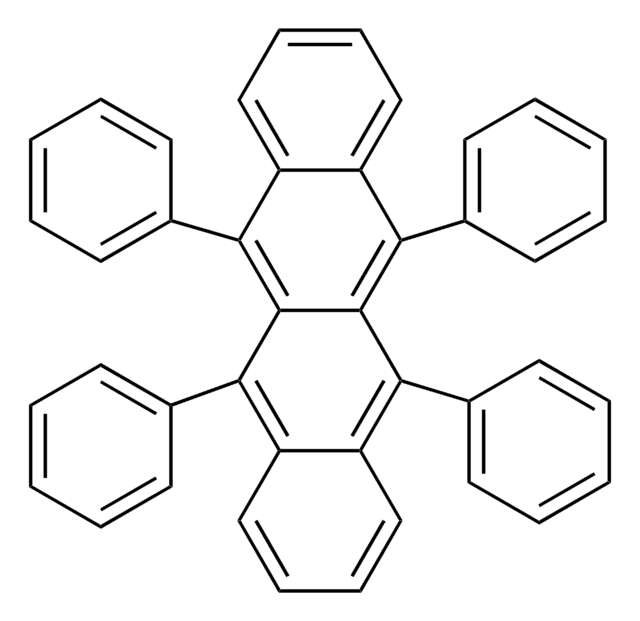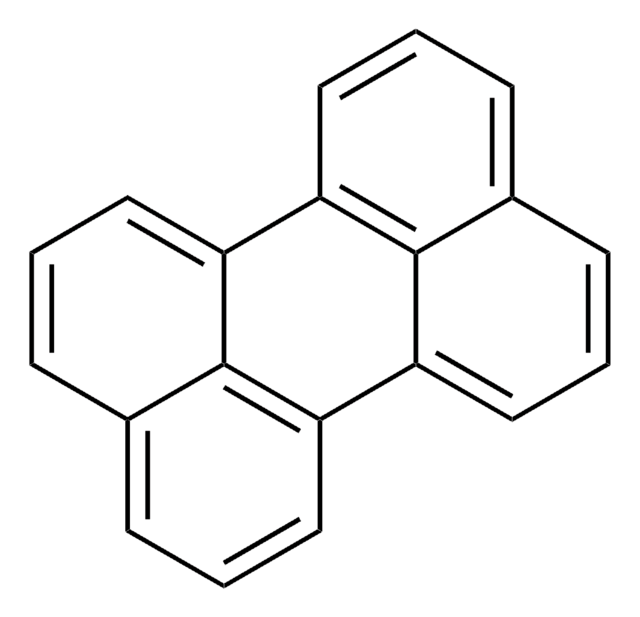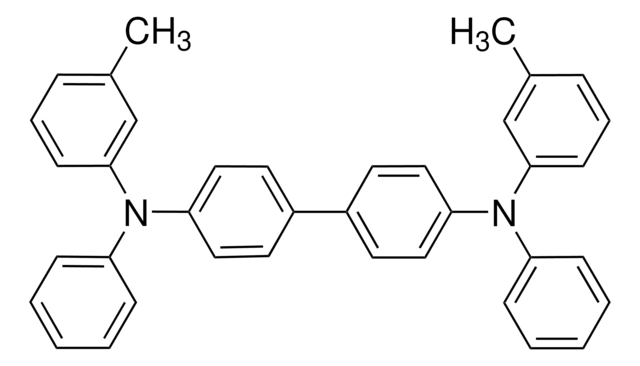753939
DBP
98% (HPLC)
Synonyme(s) :
5,10,15,20-Tetraphenylbisbenz[5,6]indeno[1,2,3-cd:1′,2′,3′-lm]perylene, Dibenzo{[f,f′]-4,4′,7,7′-tetraphenyl}diindeno[1,2,3-cd:1′,2′,3′-lm]perylene, Red 2
About This Item
Produits recommandés
Essai
98% (HPLC)
Forme
solid
Perte
0.5 wt. %, 373 °C
Pf
>400 °C
Énergie orbitale
HOMO 5.5 eV (CV)
LUMO 3.5 eV (CV)
Performance des dispositifs OPV
ITO/DBP/C60/BCP/Al
Chaîne SMILES
c1ccc(cc1)-c2c-3c(-c4ccc5c6ccc7-c8c(-c9ccc(c%10ccc-3c4c5%10)c6c79)c(-c%11ccccc%11)c%12ccccc%12c8-c%13ccccc%13)c(-c%14ccccc%14)c%15ccccc2%15
InChI
1S/C64H36/c1-5-17-37(18-6-1)53-41-25-13-14-26-42(41)54(38-19-7-2-8-20-38)62-50-34-30-46-48-32-36-52-60-51(35-31-47(58(48)60)45-29-33-49(61(53)62)59(50)57(45)46)63-55(39-21-9-3-10-22-39)43-27-15-16-28-44(43)56(64(52)63)40-23-11-4-12-24-40/h1-36H
Clé InChI
WPPDXAHGCGPUPK-UHFFFAOYSA-N
Vous recherchez des produits similaires ? Visite Guide de comparaison des produits
Code de la classe de stockage
11 - Combustible Solids
Classe de danger pour l'eau (WGK)
WGK 3
Point d'éclair (°F)
Not applicable
Point d'éclair (°C)
Not applicable
Faites votre choix parmi les versions les plus récentes :
Déjà en possession de ce produit ?
Retrouvez la documentation relative aux produits que vous avez récemment achetés dans la Bibliothèque de documents.
Les clients ont également consulté
Articles
Materials Design Concepts for Efficient Blue OLEDs: A Joint Theoretical and Experimental Study
Fabrication procedure of organic field effect transistor device using a soluble pentacene precursor.
There is widespread demand for thin, lightweight, and flexible electronic devices such as displays, sensors, actuators, and radio-frequency identification tags (RFIDs). Flexibility is necessary for scalability, portability, and mechanical robustness.
Notre équipe de scientifiques dispose d'une expérience dans tous les secteurs de la recherche, notamment en sciences de la vie, science des matériaux, synthèse chimique, chromatographie, analyse et dans de nombreux autres domaines..
Contacter notre Service technique







![Poly[2-methoxy-5-(2-ethylhexyloxy)-1,4-phenylenevinylene] average Mn 40,000-70,000](/deepweb/assets/sigmaaldrich/product/structures/344/488/b8f8179d-3970-4deb-a754-adda88cdb36f/640/b8f8179d-3970-4deb-a754-adda88cdb36f.png)